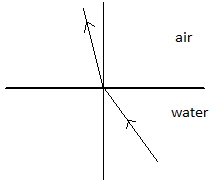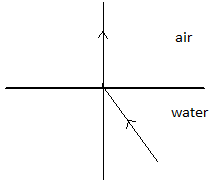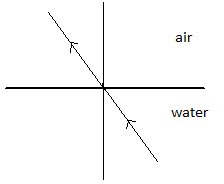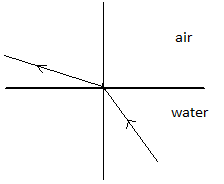Answer
64.8k+ views
Hint: We know that refraction is the bending of light rays when they travel from one material medium to another. Refraction of light is mainly caused because of the change in speed of the light wave upon crossing a boundary.
Complete answer:
If a ray of light passes across the boundary from a material in which it travels with a fast speed into a material in which it travels at a slower speed, then the light ray will bend towards the normal line.
Similarly when a ray of light passes across the boundary from a material in which its speed is slower compared to a material in which its speed is much faster, then the ray of light will bend away from the normal.
In the question given above it is clear that the ray of light is travelling from a denser medium (in which its speed is much less) into a rarer medium (in which its speed is much more). Thus, the light ray should bend away from the normal line.
When we carefully analyse the figures given in options (A), (B) and (C) we see that all three of them do not fit into our description of bending of a refracted ray of light. Thus, only option (D) displays a ray of light which bends away from the normal while travelling from a denser medium (in which its speed is much less) into a rarer medium (in which its speed is much more).
Thus, (D) is the correct answer to this question.
Note: The tendency of a ray of light to bend one direction or another is dependent upon whether the light wave speeds up or slows down upon crossing the boundary. The speed of a light wave is dependent upon the optical density of the material through which it moves. For this reason, the direction that the path of a light wave bends depends on whether the light wave is traveling from a more dense (slow) medium to a less dense (fast) medium or from a less dense medium to a more dense medium.
Complete answer:
If a ray of light passes across the boundary from a material in which it travels with a fast speed into a material in which it travels at a slower speed, then the light ray will bend towards the normal line.
Similarly when a ray of light passes across the boundary from a material in which its speed is slower compared to a material in which its speed is much faster, then the ray of light will bend away from the normal.
In the question given above it is clear that the ray of light is travelling from a denser medium (in which its speed is much less) into a rarer medium (in which its speed is much more). Thus, the light ray should bend away from the normal line.
When we carefully analyse the figures given in options (A), (B) and (C) we see that all three of them do not fit into our description of bending of a refracted ray of light. Thus, only option (D) displays a ray of light which bends away from the normal while travelling from a denser medium (in which its speed is much less) into a rarer medium (in which its speed is much more).
Thus, (D) is the correct answer to this question.
Note: The tendency of a ray of light to bend one direction or another is dependent upon whether the light wave speeds up or slows down upon crossing the boundary. The speed of a light wave is dependent upon the optical density of the material through which it moves. For this reason, the direction that the path of a light wave bends depends on whether the light wave is traveling from a more dense (slow) medium to a less dense (fast) medium or from a less dense medium to a more dense medium.
Recently Updated Pages
Write a composition in approximately 450 500 words class 10 english JEE_Main

Arrange the sentences P Q R between S1 and S5 such class 10 english JEE_Main

What is the common property of the oxides CONO and class 10 chemistry JEE_Main

What happens when dilute hydrochloric acid is added class 10 chemistry JEE_Main

If four points A63B 35C4 2 and Dx3x are given in such class 10 maths JEE_Main

The area of square inscribed in a circle of diameter class 10 maths JEE_Main

Other Pages
A boat takes 2 hours to go 8 km and come back to a class 11 physics JEE_Main

Electric field due to uniformly charged sphere class 12 physics JEE_Main

In the ground state an element has 13 electrons in class 11 chemistry JEE_Main

According to classical free electron theory A There class 11 physics JEE_Main

Differentiate between homogeneous and heterogeneous class 12 chemistry JEE_Main

Excluding stoppages the speed of a bus is 54 kmph and class 11 maths JEE_Main







